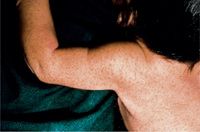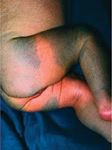- Case-Based Roundtable
- General Dermatology
- Eczema
- Chronic Hand Eczema
- Alopecia
- Aesthetics
- Vitiligo
- COVID-19
- Actinic Keratosis
- Precision Medicine and Biologics
- Rare Disease
- Wound Care
- Rosacea
- Psoriasis
- Psoriatic Arthritis
- Atopic Dermatitis
- Melasma
- NP and PA
- Skin Cancer
- Hidradenitis Suppurativa
- Drug Watch
- Pigmentary Disorders
- Acne
- Pediatric Dermatology
- Practice Management
- Prurigo Nodularis
- Buy-and-Bill
Article
Baby talk: Neonatal pigmentary skin lesions: Some require long-term follow-up
Author(s):
Neonatal pigmentary conditions are common; however, some serious conditions should be evaluated and followed by a pediatric dermatologist throughout the child's life, an expert says.

Key Points

"Neonatal pigmentary disorders include a whole spectrum of the benign, nonthreatening things that we look at, and then some big birthmarks that have significant meaning," Dr. Hansen says.
Benign, common

One benign pigmentary condition is Mongolian spots, which are extraordinarily common in heavily pigmented babies, especially black, Native American and Asian infants. These spots are caused by melanocytes located deep in the dermis.

Other pigmentary changes are less significant, and some seem to be induced by hormones of pregnancy. These include hyperpigmentation of the genitalia and also linea nigra.
In addition, small pigmentary spots often go along transient neonatal pustular melanosis, which is most common in black babies.
"The babies get freckle-like pigment spots that follow after they have had little pustules in their skin, and those freckle-like pigment spots fade over weeks to months after being born," Dr. Hansen says.
Permanent marks
A whole spectrum of permanent birthmarks exists, and Dr. Hansen notes that some are clinically important and some are not. These include moles present at birth and congenital nevi, which are very common.
"Upward of 2 percent of babies have these tiny congenital moles, and even a smaller percent - maybe 1 in 20,000 to 40,000 - have giant congenital nevi that cover major body surfaces. These are true moles and they have the true possibility of developing melanoma in them.
"Therefore, those need to be carefully looked at by a pediatric dermatologist who understands them," Dr. Hansen says.
While some congenital birthmarks can be removed, some cannot. "With the giant congenital nevi, people usually agree that there is a 5 percent chance of developing a melanoma, which is especially true if it is a giant nevus at the center of the back.
"Therefore, these are very important to be followed by a pediatric dermatologist," Dr. Hansen says.
Other birthmarks may or may not be present at birth, such as café-au-lait macules (CALM), also known as coffee-with-cream spots. When these are present in high numbers, they correlate with the condition neurofibromatosis, a genetic disorder of the nervous system that primarily affects the development and growth of neural cell tissues.
"Babies with neurofibromatosis often tend to have two or three lesions present at birth. In a Caucasian baby, it is rare for the baby to have more than one café-au-lait spot present at birth; however, in African-American babies, it is common to have one, two or three café-au-lait spots at birth and not have the genetic condition neurofibromatosis. There is sort of a racial divide in this condition," Dr. Hansen says.
Hence, two CALM at birth would not raise concern in a black infant.
"These are some of the main neonatal pigmentary spots in the newborns," Dr. Hansen says, noting that general dermatologists can refer patients to a pediatric dermatologist in suspected serious cases or when there are other concerns.
Newsletter
Like what you’re reading? Subscribe to Dermatology Times for weekly updates on therapies, innovations, and real-world practice tips.






